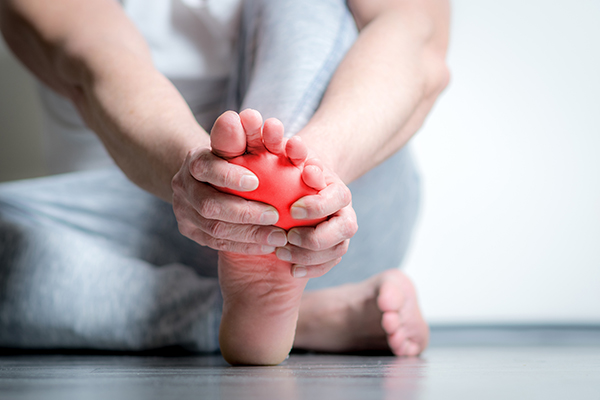
Common factors that increase your risk of developing plantar fasciitis
Here are some factors that can increase your risk of developing plantar fasciitis:Obesity or sudden weight gain
Excess weight can damage the plantar fascia, making it less able to absorb shock, which can lead to heel pain. Pregnancy also raises your risk as it increases the weight placed on the feet.Too much pressure on the heels
People who walk frequently, run, or have to stand all day at work tend to be at higher risk. Research has shown that excessive stretching and the tightness of the Achilles tendon can lead to overstraining of the plantar fascia.Foot shape and gait
People with overpronation (rolling inward on your arches when you walk or run) or flat feet (also known as low or fallen arches) are at an increased risk for plantar fasciitis because the entire soles of their feet are more likely to touch the ground when standing, per past research. Similarly, very high arches (cavus foot) raise your risk because an excessive amount of pressure is placed on the heel and the ball of the foot when standing or walking. An unusual running or walking gait can also increase pressure and tension on the plantar fascia.Wearing the wrong shoes
If shoes don't fit well, they won't support your feet. Inadequate footwear can impair walking and put additional stress on the plantar fascia. Shoes can make the difference between good health and potential foot, leg, low-back or general health problems. Shoe choice is especially important for people with diabetes or circulatory problems.Natural treatment for plantar fasciitis
When left untreated, plantar fasciitis can become a chronic condition and leave you more vulnerable to knee, hip and back problems. Here's a look at several natural approaches to treat plantar fasciitis.Exercise
Here are six exercises from physical therapists that you can try at home. Plantar fascia massage. You should not experience pain during this exercise. Apply enough pressure to feel a gentle stretch, but not pain.- Sit in a chair or stand with one foot resting on a small ball or frozen water bottle. A frozen water bottle is useful as the ice helps reduce inflammation.
- Gently roll the ball or water bottle forward and backward under your foot. Start at just below the ball of your foot and end just before your heel.
- Roll the ball or bottle back and forth slowly 10 times for each foot. Do two sets per foot.
- Do this exercise once daily.
- Stand with the balls of your feet at the edge of the bottom step.
- With your heels hanging off the edge, slowly and gently lower your heels just below the edge of the step. You may feel a stretch in your calf muscle.
- Slowly rise onto the balls of your feet.
- Repeat this 10 times, then rest. Complete two sets of this exercise.
- Do this exercise once daily.
- Sit upright on the floor with your legs straight out in front of you. Make sure to avoid any hip movement while doing this exercise.
- Place your left leg over your right leg with a resistance band secured around your upper foot and looped around the bottom of your lower foot. Hold the end of the band in your hand.
- Slowly move your upper foot (the one with the resistance band around it) away from the lower foot. To do this, rotate your ankle inward and slowly return it to the starting position.
- Repeat 10 times and complete two sets per foot.
- Do this exercise once daily.
- Sit upright in a chair with one foot resting on a towel and spread your toes.
- Curl your toes to scrunch and draw the towel toward you 10 times. Do two sets per foot.
- Do this exercise once daily.
- Sit in a chair and cross one leg over the other knee, so your ankle is on top of your other leg.
- With one hand holding your ankle and the other holding your toes, gently pull your toes backward until you feel a stretch in the bottom of your foot.
- Hold this position for 20 seconds and repeat three times for both feet.
- Do this exercise once daily.
- Stand upright facing a wall at arm’s length and place your hands flat on the wall.
- Keeping both feet flat on the floor, extend one leg straight backward, bending your front leg until you feel a stretch in the calf of your back leg.
- Hold for 20 seconds and repeat three times for both legs.
- Do this exercise once daily.
Cold therapy
Applying ice to the affected foot for 20 minutes three or four times daily should help lessen plantar fasciitis pain.Ginger
Although no studies have explored the effect of ginger on people with plantar fasciitis, some medical experts recommend this herb for relieving plantar fasciitis-related pain and inflammation. (Related: 9 Natural remedies for treating plantar fasciitis pain.)Magnetic therapy
Magnetic therapy (a form of alternative medicine that involves delivering magnetic fields directly to the body) is often touted as a natural means of easing plantar fasciitis pain. It may be worth noting, however, that a 2003 study of 101 adults revealed that magnetic insoles didn't protect against plantar fasciitis any more than non-magnetic insoles. To increase your defense against plantar fasciitis, aim to maintain a healthy weight, wear supportive shoes, and replace running shoes after every 500 miles of use. Visit NaturalMedicine.news for more about natural remedies for pains and illnesses. Watch the following video to learn about six exercises that can help end chronic foot pain. This video is from the Daily Videos channel on Brighteon.com.More related stories:
7 Easy exercises and stretches to stop foot pain for good. 10 Tried-and-tested ways to remedy plantar fasciitis. Are your "dogs" barking? Researchers develop tech to relieve foot pain for people who have to stand all day. Sources include: OmneChiropractic.com ChoosePT.com Brighteon.comNatural alternatives to OTC drugs for your survival medicine cabinet
By Olivia Cook // Share
AI-generated ads and addicting psychiatric medications make for a “deadly cocktail”
By Belle Carter // Share
DISEASES OF THE MIND: Climate anxiety, Trump Derangement Syndrome and gender fluidity
By S.D. Wells // Share
FEAR REBOOT: “Health experts,” CDC claim COVID-19 cases are rising again
By Arsenio Toledo // Share
MISOGYNY in Ukraine’s military compounding the woes of female soldiers
By Ramon Tomey // Share
North Korea advances nuclear submarine program as Kim Jong Un oversees missile tests
By kevinhughes // Share
USCIS touts historic immigration enforcement under Trump administration
By willowt // Share
Nvidia strengthens AI dominance with strategic Groq talent acquisition and licensing deal
By kevinhughes // Share
Landmark study links even light alcohol use to soaring mouth cancer risk
By avagrace // Share











